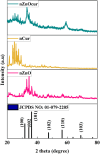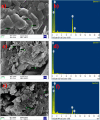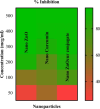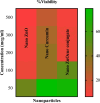Comprehensive Characterization and Biological and Safety Evaluation of Zinc Oxide-Curcumin Nanoconjugates: Unraveling Synergistic Effects for Enhanced Therapeutic Applications
- PMID: 40621024
- PMCID: PMC12223860
- DOI: 10.1021/acsomega.5c02224
Comprehensive Characterization and Biological and Safety Evaluation of Zinc Oxide-Curcumin Nanoconjugates: Unraveling Synergistic Effects for Enhanced Therapeutic Applications
Abstract
Nanoparticles have been widely synthesized and used in various biological applications. Among the minerals, zinc (Zn) alters numerous biological pathways, and curcumin (Cur) functions mainly as the antimicrobial, anti-inflammatory, and anticancerous agent. In this study, nano-zinc oxide (nZnO), nano-curcumin (nCur), and its conjugate (nZnOcur) were synthesized through the chemical reduction method. The particles were characterized using UV-visible (UV-visible) spectroscopy, Fourier transform infrared (FTIR) spectroscopy, X-ray diffraction (XRD), scanning electron microscopy-energy-dispersive X-ray spectroscopy (SEM-EDS), high-resolution transmission electron microscopy (HR-TEM), dynamic light scattering (DLS), and ζ-potential measurements. The UV-visible spectrum revealed that nZnO had an absorbance peak at 370 nm, while nCur had peaks at 400-600 nm, and the nZnOcur conjugate had peaks at 550-650 nm and a smaller peak in the 300-400 nm range. The key functional groups identified by FTIR confirm the successful conjugation of nZnOcur nanoparticles. XRD patterns indicated the crystalline wurtzite phase of nZnO with variations in peak intensity, suggesting structural changes upon curcumin incorporation. SEM-EDS and DLS analyses provided average particle sizes of 88.41 and 122 nm; 53.81 and 98 nm; 43.41 and 102 nm for nZnO, nCur, and nZnOcur conjugate, respectively. HR-TEM images showed that nZnO (∼70 nm, spherical) transformed into rod-like nZnOcur (∼105 nm) upon conjugation with curcumin. nZnOcur had higher antibacterial activity against bacterial strains, demonstrating synergistic effects. The antioxidant capacity was greater in both nCur and nZnOcur conjugates, while anti-inflammatory assays indicated significant protein denaturation inhibition with all three nanoparticles. Cytotoxicity tests revealed that nZnO had higher toxicity, and the acute oral toxicity study indicated nZnOcur conjugate as least toxic, with LD50 value of 425.4 mg/kg. Overall, the findings underscore the nZnOcur conjugate as a promising and safer nanoparticle for antimicrobial, anti-inflammatory, and antioxidant applications with least side effects.
© 2025 The Authors. Published by American Chemical Society.
Figures












Similar articles
-
Phyto-Fabrication Tribulus terrestris Mediated Iron Oxide Nanoparticles: A Promising Approach of Antioxidant and Anticancer Activities via in vitro and in silico Studies.Front Biosci (Landmark Ed). 2025 May 30;30(6):25164. doi: 10.31083/FBL25164. Front Biosci (Landmark Ed). 2025. PMID: 40613274
-
Microwave assisted starch stabilized green synthesis of zinc oxide nanoparticles for antibacterial and photocatalytic applications.Sci Rep. 2025 Aug 2;15(1):28288. doi: 10.1038/s41598-025-14193-8. Sci Rep. 2025. PMID: 40753352 Free PMC article.
-
Prescription of Controlled Substances: Benefits and Risks.2025 Jul 6. In: StatPearls [Internet]. Treasure Island (FL): StatPearls Publishing; 2025 Jan–. 2025 Jul 6. In: StatPearls [Internet]. Treasure Island (FL): StatPearls Publishing; 2025 Jan–. PMID: 30726003 Free Books & Documents.
-
The Black Book of Psychotropic Dosing and Monitoring.Psychopharmacol Bull. 2024 Jul 8;54(3):8-59. Psychopharmacol Bull. 2024. PMID: 38993656 Free PMC article. Review.
-
Management of urinary stones by experts in stone disease (ESD 2025).Arch Ital Urol Androl. 2025 Jun 30;97(2):14085. doi: 10.4081/aiua.2025.14085. Epub 2025 Jun 30. Arch Ital Urol Androl. 2025. PMID: 40583613 Review.
References
-
- Dzobo K.. The role of natural products as sources of therapeutic agents for innovative drug discovery. Comp. Pharmacol. 2022;9:408–422. doi: 10.1016/B978-0-12-820472-6.00041-4. - DOI
-
- Males I., Pedisić S., Zorić Z., Elez-Garofulić I., Repajić M., You L., Vladimir-Knežević S., Butorac D., Dragović-Uzelac V.. The medicinal and aromatic plants as ingredients in functional beverage production. J. Funct. Foods. 2022;96:105210. doi: 10.1016/j.jff.2022.105210. - DOI
-
- Iweala E. J., Uche M. E., Dike E. D., Etumnu L. R., Dokunmu T. M., Oluwapelumi A. E., Okoro B. C., Dania O. E., Adebayo A. H., Ugbogu E. A.. Curcuma longa (Turmeric): Ethnomedicinal uses, phytochemistry, pharmacological activities and toxicity profilesA review. Pharmacol. Res. Mod. Chin. Med. 2023;6:100222. doi: 10.1016/j.prmcm.2023.100222. - DOI
-
- Phytochemical Potentials for Dermatological Applications, 1st ed.; Miere, F. ; Vicas, S. I. ; Mandal, A. K. , Eds.; CRC Press: FL, 2025; p 296.
LinkOut - more resources
Full Text Sources
Research Materials
